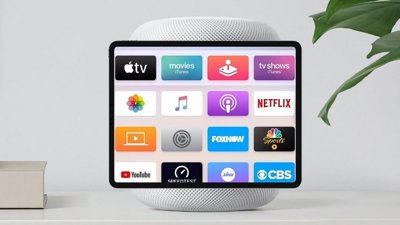Ultrahuman's Home is a departure from its usual wearable tech, with the new iPhone-connected room sensor able to tell if the area the user spends their time in is a healthy environment.
Wearable devices like the Apple Watch offer owners a view of their lifestyle based on their actions and activity, but they are somewhat limited in terms of what they detect in the user's environment. A person could be physically fit, but they could also stand to benefit from more exposure to sunlight or proper humidity in a room.
To solve this, the Ultrahuman Home is a device designed to be placed in a room to monitor various factors that can affect a person's health. Rather than the person, it's looking at the physical space they inhabit.
The data points are combined with those from a person's health data, such as sleep and stress markers, to give a more overall view of a person's health. By correlating the person's health with room data points over time, recommendations could be offered to make changes to the environment, and therefore could improve the user's life.
The Ultrahuman Home is capable of monitoring multiple elements, including light, with it measuring sunlight and UV levels to determine if the user's getting enough vitamin D for maintaining a healthy sleep pattern. Blue light exposure is also monitored, with artificial light suppressing melatonin, a sleep-inducing hormone.
Particulate matter, microscopic particles in the air, is also monitored to improve a user's respiratory health. High levels of particulate matter can result in respiratory system damage, cardiovascular dysfunction, and other chronic diseases.
The level of room humidity, also detected by the device, can impact users in two ways. Too little humidity increases the chance of respiratory infections, while too much allows for the growth of microorganisms and risks ventilator-associated pneumonia.
Noise detection feeds back the level of audio interruptions a user may encounter in a room, with traffic and urban environments tending to promote sleep mobility, decreasing the efficiency of sleep, and potentially disturbing sleepers into waking up at night.
Lastly, there's a smoke sensor, which helps protect against other respiratory issues, as well as fire hazards.
Ultrahuman's existing products already connect to Apple's hardware ecosystem via an app with a connection to Apple's HealthKit. Since the company already can work with data compiled from Apple hardware like the Apple Watch and iPhone in HealthKit, it can combine the room data with it to provide more useful health recommendations.
"Using the unique markers from the Home device, we'd be able to link an individual's health markers ( sleep, stress ) to their environment ( temperature, humidity and light exposure )," according to founder and CEO Mohit Kumar. "This on-body and off-body health tracking integration is the first time ever in the health monitoring space."
Ultrahuman Home will be available for purchase on Kickstarter at the end of January for $349. Shipments are expected to start in July.
AppleInsider is at the 2024 Consumer Electronics Show this week until January 12, with our reporters seeing the latest HomeKit devices, Apple accessories, 8K monitors, massive televisions, and more in-person throughout the event. You can keep up with the event's coverage on the AppleInsider app, our YouTube channel, on Facebook, and our X @AppleInsider account for the latest news as it breaks. Also, check out our official Instagram account for exclusive photos and videos throughout the event.
 Malcolm Owen
Malcolm Owen





-m.jpg)


-m.jpg)






 Christine McKee
Christine McKee
 Chip Loder
Chip Loder
 Oliver Haslam
Oliver Haslam

 William Gallagher
William Gallagher
 Amber Neely
Amber Neely

 Andrew Orr
Andrew Orr







2 Comments
GREAT!
It would be like my mom and my doctor barking at me over my phone 24/7.
This would be far more compelling if it also monitored byproducts of combustion (for owners of gas stoves, oil and gas heating systems, appliances, etc.), natural gas, and even more so, radon. In other words, provide additional insight into things that are known and immediate health and safety hazards in addition to those things that may be deleterious to longterm health and wellbeing over time, like excessive ambient noise and low humidity.